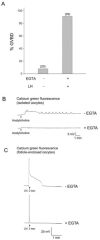Meiotic resumption in response to luteinizing hormone is independent of a Gi family G protein or calcium in the mouse oocyte
- PMID: 16949564
- PMCID: PMC1864934
- DOI: 10.1016/j.ydbio.2006.07.039
Meiotic resumption in response to luteinizing hormone is independent of a Gi family G protein or calcium in the mouse oocyte
Abstract
The signaling pathway by which luteinizing hormone (LH) acts on the somatic cells of vertebrate ovarian follicles to stimulate meiotic resumption in the oocyte requires a decrease in cAMP in the oocyte, but how cAMP is decreased is unknown. Activation of Gi family G proteins can lower cAMP by inhibiting adenylate cyclase or stimulating a cyclic nucleotide phosphodiesterase, but we show here that inhibition of this class of G proteins by injection of pertussis toxin into follicle-enclosed mouse oocytes does not prevent meiotic resumption in response to LH. Likewise, elevation of Ca2+ can lower cAMP through its action on Ca2+-sensitive adenylate cyclases or phosphodiesterases, but inhibition of a Ca2+ rise by injection of EGTA into follicle-enclosed mouse oocytes does not inhibit the LH response. Thus, neither of these well-known mechanisms of cAMP regulation can account for LH signaling to the oocyte in the mouse ovary.
Figures





References
-
- Andersen CB, Roth RA, Conti M. Protein kinase B/Akt induces resumption of meiosis in Xenopus oocytes. J Biol Chem. 1998;273:18705–18708. - PubMed
Publication types
MeSH terms
Substances
Grants and funding
LinkOut - more resources
Full Text Sources
Miscellaneous

